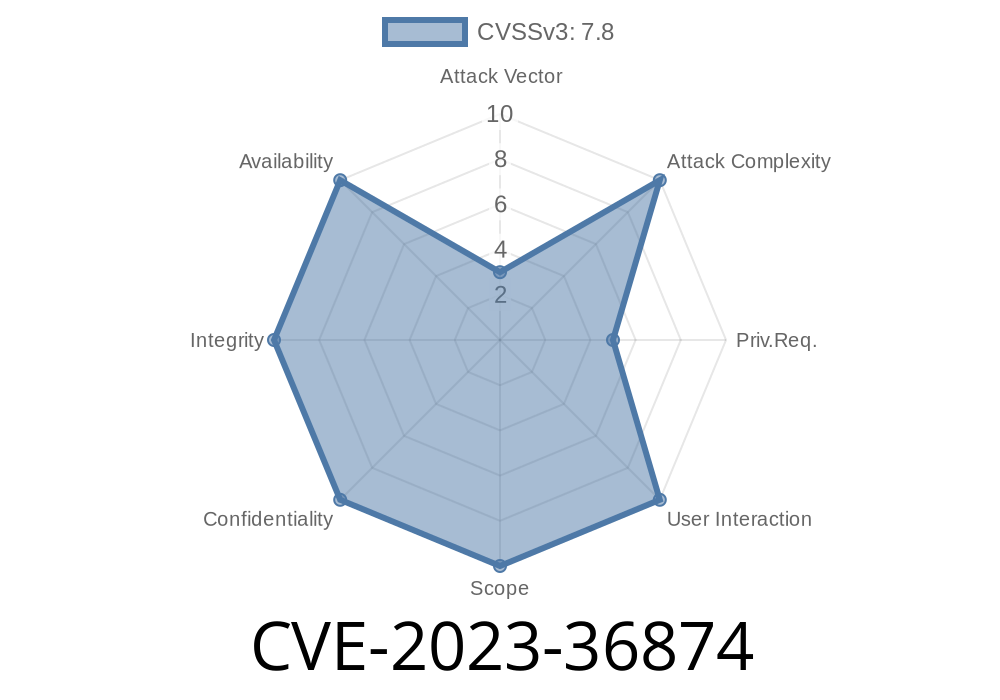Microsoft Windows Error Reporting Service (WERS) is designed to help users diagnose and fix problems associated with their Windows operating system. However, a new vulnerability, identified as CVE-2023-36874, has emerged that poses a threat to Windows users. This vulnerability allows an attacker to exploit the Windows Error Reporting Service and potentially elevate their privileges within the system, leading to more extensive and potentially damaging access to the affected machine.
In this post, we will delve into the details of the CVE-2023-36874 vulnerability, exploring its mechanisms and potential impacts. Additionally, we will provide guidance on how users can mitigate or protect themselves from this threat.
Exploit Details
The CVE-2023-36874 vulnerability stems from a flaw in how the Windows Error Reporting service handles privileged file operations. An attacker who successfully exploits this vulnerability could potentially execute arbitrary code with elevated privileges on the system. This may enable the attacker to gain unauthorized access, install malicious programs, or perform other nefarious actions, ultimately compromising the entire system.
The vulnerability can be triggered through a specially-crafted file designed to exploit the WERS service. The following code snippet demonstrates one possibility for crafting such a malicious file:
#include <windows.h>
int main() {
LPWSTR pWERCommandLine = L"\\\\?\\C:\\malicious.dll";
HMODULE hWerMod = LoadLibraryEx(pWERCommandLine, NULL, LOAD_LIBRARY_AS_DATAFILE);
if (hWerMod != NULL) {
FARPROC pFunctionAddress = GetProcAddress(hWerMod, "ExploitFunction");
if (pFunctionAddress != NULL) {
pFunctionAddress();
}
}
}
In this code snippet, an attacker develops a malicious Dynamic Link Library (DLL) and names it "malicious.dll". The code is designed to exploit the WERS service by loading the malicious DLL and invoking the "ExploitFunction" with the purpose of elevating privileges.
Original References
For more detailed technical information on the CVE-2023-36874 vulnerability, please refer to the original references provided:
- Microsoft Security Advisory - CVE-2023-36874
- CVE Details Official Listing - CVE-2023-36874
Mitigation Steps
To mitigate the risk of CVE-2023-36874, Microsoft has released a series of patches addressing the issue. Users are strongly recommended to apply the appropriate patch for their specific Windows version. The patch should be downloaded and installed from the official Microsoft website to ensure authenticity. Remember to always keep your software up-to-date, as this is a crucial step in overall system security.
To further protect systems from this vulnerability, users should follow these additional steps
1. Enable Windows Defender, an integrated security system that can help detect and prevent potential threats.
2. Use strong and unique passwords for system accounts to reduce the risk of attackers gaining unauthorized access through password guessing.
3. Refrain from opening untrusted files or visiting suspicious websites, as these can serve as entry points for attacks.
Conclusion
The CVE-2023-36874 vulnerability exposes Windows users to potential elevation of privilege attacks due to a flaw in the Windows Error Reporting Service. By exploiting this vulnerability, attackers could execute code with elevated privileges, compromising the system as a whole. Microsoft has provided patches to address this issue, and all Windows users should apply the appropriate patch as soon as possible. In addition to patching, users should follow best security practices to protect their systems from further harm.
Timeline
Published on: 07/11/2023 18:15:00 UTC
Last modified on: 07/12/2023 12:46:00 UTC
